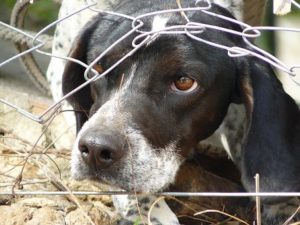Pet Containment Systems: Wireless vs Wired Dog Fence [in ground]?
One important decision every dog owner has to make is how to contain your dog. If you are in the city, with shared yards or parks, a leash may be your only option, but if your house has its own yard, you will have a few options to consider. Of course, there is the obvious option of a wooden or chain-link fence. These both keep dogs in and intruders out (human or animal), and even provide privacy from neighbors. However, these above-ground fences are quite expensive (they start at $2500), and often don’t keep determined dogs in – they will just dig or chew until they’re free.

A great alternative to a wooden or chain-link fence is a pet containment system – a “fence” that consists of a transmitter, which sends out a signal to establish a boundary around your yard, and a receiver, a small box on the dog collar that is in constant communication with the transmitter. If you are planning to install a pet containment system, you should know the differences between the two options.

To help you decide what best suits your needs, it us important to consider the strengths and weaknesses of each system. We have broken these down and compared them by category below.
Setup Time
Wired : This system takes more work up front. In addition to plugging in the receiver and training your dog, you’ll need to dig a 2-3” trench for the wire. This takes an average of 1-2 days, so plan to set aside a weekend. If you have money to pay professional installers, it could take as little as an afternoon.
Winner: Wireless is a cinch!

Cost
Wired: A wired system varies more in price because a larger area will need a powerful transmitter and a lot of wire. You can spend as little as $150 for a basic unit with enough wire for a small yard, or as much as $500 to cover a much larger area (up to 100 acres). Many of these collars are rechargeable, so there is no need to buy a separate battery. In addition to the unit and wire, though, you’ll also need to plan on the cost of installation unless you plan to dig the trench yourself. This will add anywhere from $500 to $2000 to your total cost
Winner: Wireless once again takes the day, because it does not require setup costs, and its cost isn’t affected as much by the size of your property.
Portability
Wired: You can imagine the headache involved in relocating one of these. If you are not sure you will be in the same location for long, you can always install the wire above the grass, which would make the system slightly easier to remove and relocate. Ultimately, though, the transmitter might be okay to relocate, but it would make more sense to leave the wiring in place and purchase and install new wire at the new location.
Winner: Wireless systems are clearly once again the winner when it comes to being portable. If you are even thinking about moving in the next year or two, one of these would make that process much easier for you and your dog.

Flexibility
Wired: A wired system can send its wires around any shape, no matter how large (some brands advertize up to 100 acres). The wires can be doubled to prevent a stubborn dog from escaping. And finally, the wires can be run around objects such as flower gardens, swimming pool, or even a private putting green in order to keep them safe from pup intruders. Setups can vary infinitely, so if you have an unusual-shaped yard or special areas to protect, this is the system for you.
Winner: Wired

Intensity
Wired: Many wired systems have a set length of prongs and also a set intensity for the correction, so a sensitive (or small) dog might feel strongly what a stubborn (or big) dog wouldn’t blink at.
Winner: Wireless
Repairs
Wired: The long wires dug into the ground will make repairs tricky. You will need to turn off the transmitter, and use a special tool to walk along the perimeter and find the gap in the wire. However, the wired system does have one positive in this category: because the correction is only felt when the signal is received, the dog will not receive a shock after the transmitter has stopped working.
Winner: Wireless for you, Wired for your dog.

Reliability
Wired: The wired system has a negligible margin of error, since it is held in place by its wires! Its signal is also not affected by the weather or landscape.
Winner: Wired

WOLF-HYBRIDS AND THE CONTAINMENT THAT I USE
I apologize in advance that this is so long, if you do not have the time to read all of it right now I completely understand. Once I start writing about my beloved pets, I have a hard time stopping. Lol. I live on a few acres in the Colorado Rocky Mountains, and had a breeder of wolf-hybrids move in next door to me, and his female had just had a litter of pups, so he gave me my first male wolf-hybrid. Then, he rescued a female wolf-hybrid that was being severely abused and brought her to my house because I had a great containment set up, and I am here with them 24/7, 365 days a year, and he knows how much I love my pups, and would never do anything to bring harm to them. Long story short, the female ended up mating with my male hybrid, after she had refused to be mated with by any males for the first four years of her life, so it was rather unexpected. They ended up have 12 pups, all of which my husband and I helped her give birth to and raise for first 12 weeks of their lives. Then, we found appropriate homes for 10 of the pups with friends and family members who have the proper containment for them and I only gave them to families who have one person who stays home / works from home, because they cannot be kenneled and require pretty much constant supervision. They are all spayed and neutered now, so that we don’t have any more puppies. Although I wouldn’t change that experience for the world, having 12 wolf-hybrid puppies and two adult wolf hybrids was one of the most exhausting things that I have ever done. How did you come to have 14 of them? That is so neat. I would love to have a sanctuary for wolf-hybrids, one day. They are so misunderstood, and such amazing creatures.
In regard to the question of whether or not I ever considered using an underground / wireless fence, my husband and I definitely discussed that option at length. Especially at first, when we only had the one wolf-hybrid. I liked the idea of a wireless / underground fence for several reasons. Mainly, because we live in a beautiful canyon, surrounded by mountain views, and we have a creek that runs through our front yard that I always want to be able to see, and did not want to block out any of the views that we have with solid, wooden fencing. And also, because the ground is so rocky where we live, and full of massive boulders, it can be difficult to put fence posts in the ground. However, once we discussed the option of installing underground fencing with the guy who breeds these hybrids, he informed us that those types of containment systems (underground / wireless electric shock fences) do not work for wolf-hybrids, at least not for the ones he has bred.
These hybrids have such a strong prey-drive that they will run straight through an electric fence, even with the highest level of static shock. Also, they are incredibly smart animals, as I am sure you know, and the breeder said when he tried to use an electric fence with his pack, they figured out how to make the receiver collar beep until the battery died, then they would leave the containment without getting shocked. Furthermore, if the system shocks them upon re-entering, they might not re-enter the containment area, and I did not want to take that risk. But above all, the biggest concern that I have with electric fencing is hurting my beloved canine companions. Even if the shock doesn’t cause long term, physical damage to my precious babies, I know from everything that I learned about behavioral training, classical conditioning, and shock while receiving my degree in psychology, that these animals would definitely start to distrust me / being in our yard, if I used a shock collar on them.
On top of that, their breed, especially the males, are known to become quite aggressive if they are being threatened, or hurt, and perceive that they are in any kind of danger. I fear that if I shocked them, they would either become agitated and attack one another, or turn on me. And those are all risks that I am not willing to take. Another factor with underground fencing and living in the mountains is that where we live, we are surrounded by bears, deer, mountain lions, and wild animals of all kinds. I have had bears come onto my property and walk right in front of the 6-foot fencing that we put up for our hybrids, and if that fence was not there, I can guarantee that my wolves would have chased after that bear, shock or no shock. And I am not certain what would have happened to any of the animal involved in that situation. Also, I worry about wild animals coming into my yard if I did not have a tall, physical fence to keep them out. Bears wander all around the yards of my neighbors who don’t have fences.
For all of those reasons, we opted to install several layers of metal, chain link fencing and chicken wire, with 6-foot metal pound posts dug into the ground every two feet around the entire perimeter, in order to hold the fencing up. Honestly, I was initially concerned that four large wolf-hybrids would be able to break out of this fence if they really wanted to. But even when they are all four jumping on the fence in the same area, it stays sturdy. They have never escaped (in nearly four years). Truthfully, they don’t really even try to escape, unless there is a wild animal taunting them. However, that is not the case with all hybrids and in some cases, they need chicken wire on the top and buried under the ground, at least a foot deep in order to keep them from digging, or jumping / climbing out of the fence. I feel very thankful that I am able to work from home, and keep a close eye on them and even more thankful that they really do not seem to have any desire to escape. I chalk that up to being because they are pack animals and because they have a pack to live with here, with mama, papa, and two of their male children, they are content and do not wish to go anywhere. And I am very happy about that. How about you? What kind of containment do you use for yours?

![Best Cheap Dog Foods - our Top 10 Picks of High Quality Brands That Are Still Affordable [Under $1 per pound!] in 2023 Best Cheap Dog Foods - our Top 10 Picks of High Quality Brands That Are Still Affordable [Under $1 per pound!] in 2023](https://shihtzuexpert.com/wp-content/uploads/2018/01/Best-Cheap-Dog-Food-Featured-image.png)
![Custom shape wireless dog fence [Electric Fencing and Electric Barrier Systems] Custom shape wireless dog fence [Electric Fencing and Electric Barrier Systems]](https://shihtzuexpert.com/wp-content/uploads/2019/07/Custom-Shape-Wireless-Dog-Fence-Review.png)

